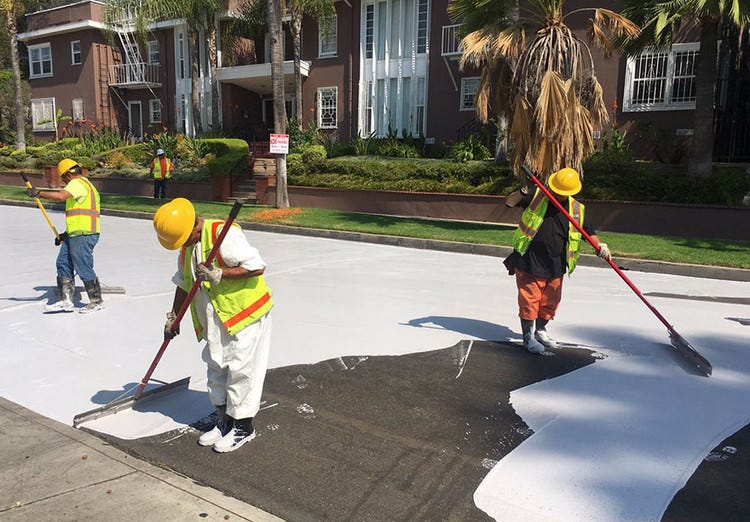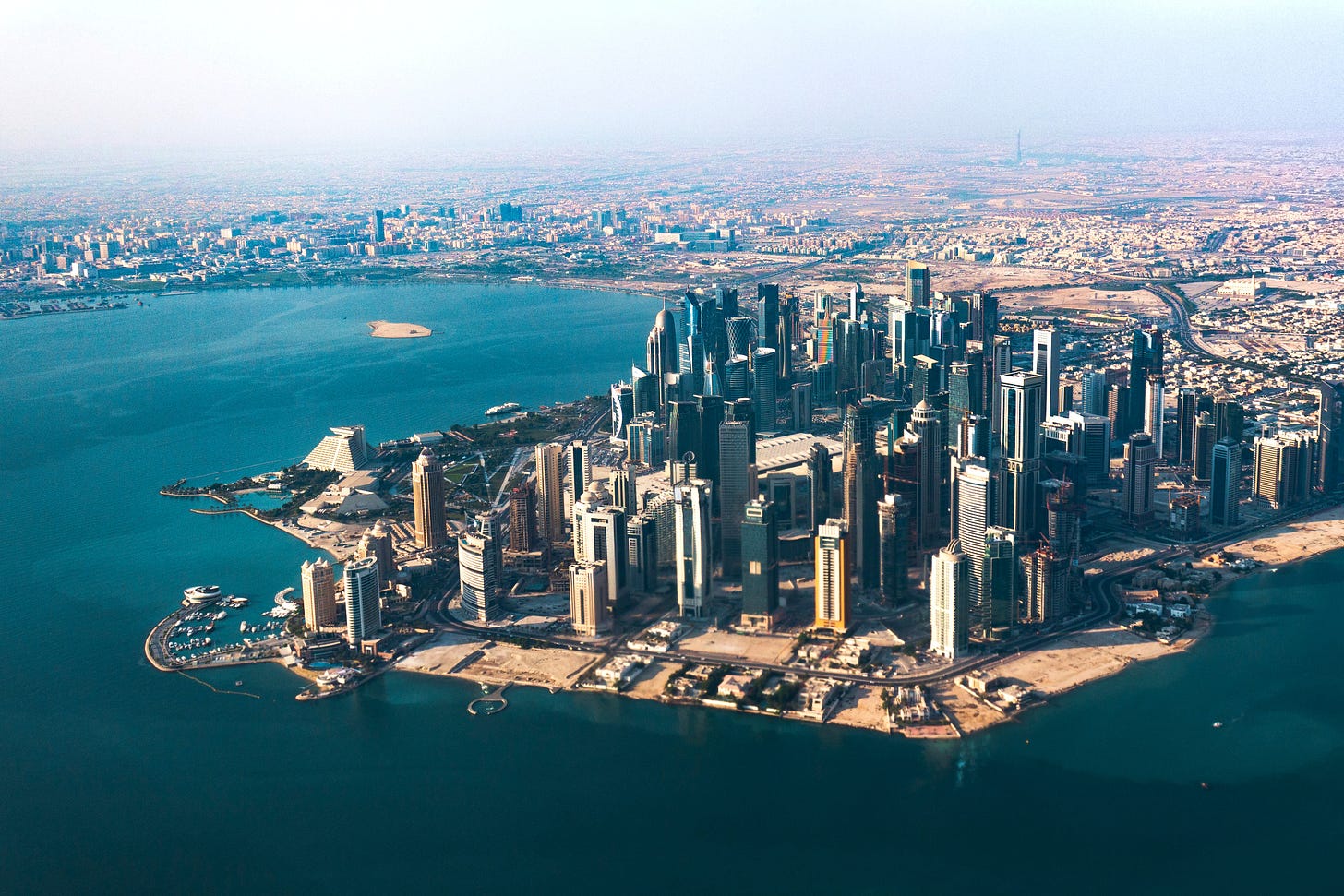🕺COP26: It’s done
And how not to A/C the outdoors 🙅🏾♀️🥶
Climate Solutions // I S S U E # 5 8 // E X T R E M E H E A T
COP26: It’s done
The gavel has fallen at the climate talks in Glasgow, Scotland. Let’s take stock. My Quartz colleague Tim McDonnell writes, “COP26 had one job: To keep 1.5 degrees Celsius, the global warming limit prescribed by the 2015 Paris Agreement, alive. That dream is not dead, but it is on life support.” So what did get done?
The UN summit agrees to phase-out of fossil fuels subsidies for first time
India’s commits to net-zero by 2070
Deadlines for climate goals accelerated
Double-counting carbon credits, an accounting loophole, banned
All together, if every country delivered on today’s promises, we’re headed for a 1.9°C world by 2100, reports Carbon Brief. That’s progress. Existing policies get us to a 2.4°C world. The pre-Paris Agreement trajectory was 3.7°C.
But progress is only possible “if we don’t rest on our laurels and see how things go,” said Nigel Topping, a climate economist. Industrialized countries need to ratchet up their ambitions soon, and help finance poor countries’ energy transition. That’s far better than where we were, says William Pizer, a former US climate negotiator: “2 C is really possible, and just a few years ago it really wasn’t.”
But a much hotter world is coming even in a best-case scenario. How we will we adapt is what Dana Smith writes for us this week. In the post, many cultures have faced similar problems. We’ve forgotten, or ignored, many of the lessons built into their homes and buildings. It’s time to rediscover them.
Mike Coren
Want to chat? You can reach me anytime at mj@hothouse.solutions, Twitter, or schedule a time to chat here.
Our extreme heat poll
What's your favorite way to beat the heat?
We’ll send you the results next week
Should air conditioning be a human right?
If humans can’t adapt to extreme heat, our infrastructure must
Qatar is so hot, and so rich, the small Middle Eastern country is air-conditioning the outdoors. Strolling through the country’s capital, Doha, people can be seen sitting on air-conditioning grates at outdoor cafes. Refrigerated air blows onto sidewalks in outdoor shopping malls. In a 40,000-seat open-air soccer stadium built for the 2022 FIFA World Cup, a complex labyrinth of pipes, fans, and vents cools and recirculates the air to keep the stadium a balmy 75°F.
Almost all of it is powered by oil and gas.
Doha is a fleeting oasis in a climate dystopia. Daytime temperatures regularly soar above 100°F from May to September (the annual average is 92.8°F). And the country is getting hotter faster than almost anywhere else in the world. By some estimates, it has already exceeded a 2°C increase over the last 100 years. At this rate, parts of the Persian Gulf will be unlivable for humans without artificial cooling by 2030 thanks to the deadly combination of heat and humidity. Doha’s wet bulb globe temperatures—a composite of heat, humidity, wind speed, and surface radiation—are near 33°C. And 35°C is considered the upper limit for human survivability.
To keep the country livable, air conditioning is now nearly universal. “Our modern approach to dealing with heat is just to mechanize it, to really bring mechanical systems to cool our environments,” says Vivek Shandas, a professor of climate adaptation at Portland State University who has worked in Doha. But conventional air conditioning, at best, is a short-term solution exacerbating the problem. “Much of [human] resiliency to hot environments relies on an exhaustible level of energy resources.”
Keeping cool as a human right
Qatar is not alone in its approach to heat. Air conditioning has been proposed as a human right by Sustainable Energy for All, an UN-affiliated human rights organization, since it is essential for survival in some countries. In the US, several states have passed laws requiring landlords to provide air conditioning for tenants. In Dallas, Texas, for example, housing standards require that owners provide “refrigerated air” that can keep rooms at least 15 degrees cooler than the outside temperature, with a maximum indoor temperature of 85°F. Similarly, in Phoenix, Arizona, rental homes must have cooling systems in place to keep rooms under 86°F.
The push for universal air conditioning is now happening even in historically cooler climates. Ladd Keith, an assistant professor of planning and sustainable built environments at the University of Arizona, says he’s received requests to help implement similar legislation in cities across the Pacific Northwest, where unprecedented heatwave this year saw temperatures hit 118°F. A lack of air conditioning during the June heat dome proved deadly: 54 people died of hyperthermia in Portland, Oregon; only one had a working air conditioning unit.
Yet few see universal air conditioning as a sustainable long-term solution. “If you start to require landlords to provide air conditioning, and you increase the air conditioning adoption rate, more people with air conditioning means more greenhouse gas emissions,” Keith says.
Not that most countries could afford to deliver A/C to anyone but the rich. Qatar, an oil-rich emirate with a per capita GDP above Finland, can do it by selling or burning its huge oil reserves, massively subsidizing the cost of energy. In the US, citizens are pretty much on their own. For Arizonans, energy bills more than triple during the summer, reaching nearly $500 a month. As a result, for many people, the problem is not access to A/C units but the lack of affordable energy.
A second issue is who is left out. Texas failed to pass a bill this summer that would require air conditioning in its prisons. At least 13 incarcerated men have died from heatstroke in the state over the past 10 years. People who work outdoors—who have some of the highest rates of heat death—are also excluded. In Qatar, an estimated 2,275 migrant workers have died from heat-related cardiac arrest since 2011, many of whom were building the air-conditioned soccer stadiums. In the US, the average person of color lives in a hotter neighborhood in all but six of the 175 biggest metro areas (based on urban heat island data). Providing these communities with air conditioning would save lives. But this stop-gap must be accompanied by longer-term sustainable solutions.
“Typically, those that don't have air conditioning right now are lower-income, and they're probably the ones that need air conditioning the most,” says Keith. The key, he says, is to pair access to active cooling equipment with new strategies that will reduce our reliance on fossil fuels.
Using the sun to cool
Six hundred miles up the Gulf Coast from Qatar in Iraq, Basima Abdulrahman is trying to accomplish exactly that. Iraq has more than five times the oil reserves as Qatar, but the impoverished, war-torn country has a per capita GDP 12-times less than its southern neighbor.
Iraq’s infrastructure is crumbling. The country experiences frequent electricity blackouts. Some areas get just four hours of energy a day. A loss of electricity can be deadly during the Iraqi summer when temperatures can reach well over 100°F. According to Abdulrahman, the average Iraqi household relies on four air conditioning units to survive; some homes have as many as 10. Nationwide, cooling consumes 60% of the country’s energy.
Abdulrahman is working to help fix the problem—short-term and long-term—with her company, Kesk, which offers solar-powered air conditioning units as well as green building consultations. “Buildings are built in a way that they are causing a huge burden on the power grid because of how they are designed,” she says. “They are designed in a way that they keep losing energy all day.”
Kesk’s solar A/C units can run completely off the grid during the daytime, helping to relieve the nation’s struggling infrastructure while also skirting the need for fossil fuels. The system costs anywhere from $1200 to $2400, depending on the size, and includes both the solar panel and external A/C unit. Even when it’s 113°F outside, they can cool rooms to 75°F.
To advance its mission of a greener Iraq, Kesk also advises developers on how to use alternative building materials (most Iraqi structures are constructed with concrete, which absorbs and retains heat), install insulation, and seal doors and windows to increase energy efficiency. Abdulrahman, who trained as a structural engineer in the US, estimates that with these changes, a building’s energy consumption can drop by half.
Abdulrahman is not alone in her endeavor. Alternative strategies to manage heat are emerging around the world, by employing new technologies as well as reimagining ancient solutions. These approaches aim to repel heat by harnessing the environment’s physical properties.
Passive cooling techniques are not only targeting individual buildings, but entire cities. In California and Arizona, roofs and roads are being painted white to reflect the heat of the sun (a new ultra-white paint capable of cooling surfaces by nearly 20°F will aid this effort).

Urban greening projects are also underway in many US cities to convert heat-absorbing asphalt to trees that cool the surrounding area through shade and added moisture to the environment.
Some of these initiatives have succeeded. Others have massively backfired.
We’ll find out more next week.
Like what you’re reading? Share Hothouse with a friend (or many)!
Hothouse is a weekly climate action newsletter written and edited by Mike Coren and Cadence Bambenek. We rely on readers to support us.







